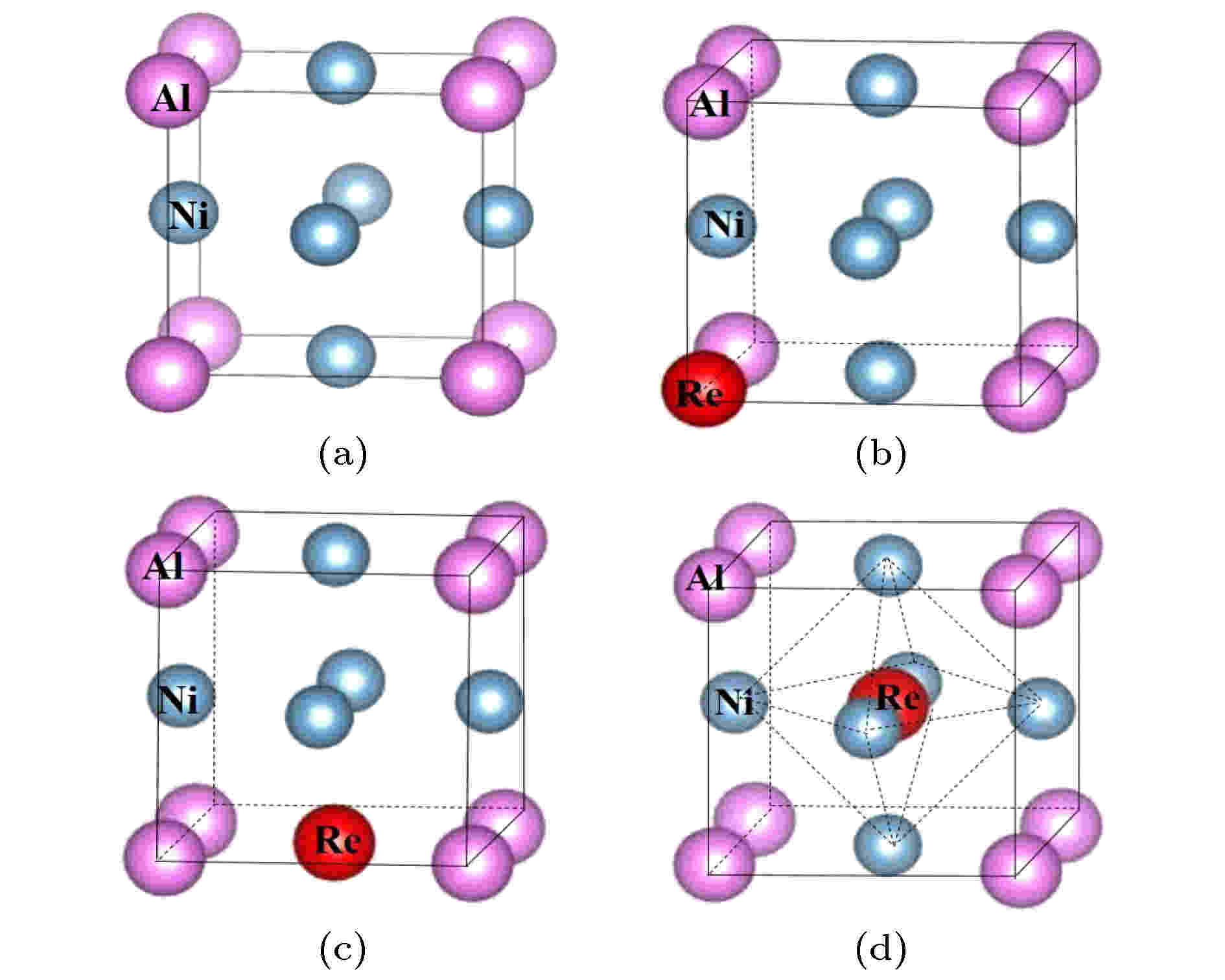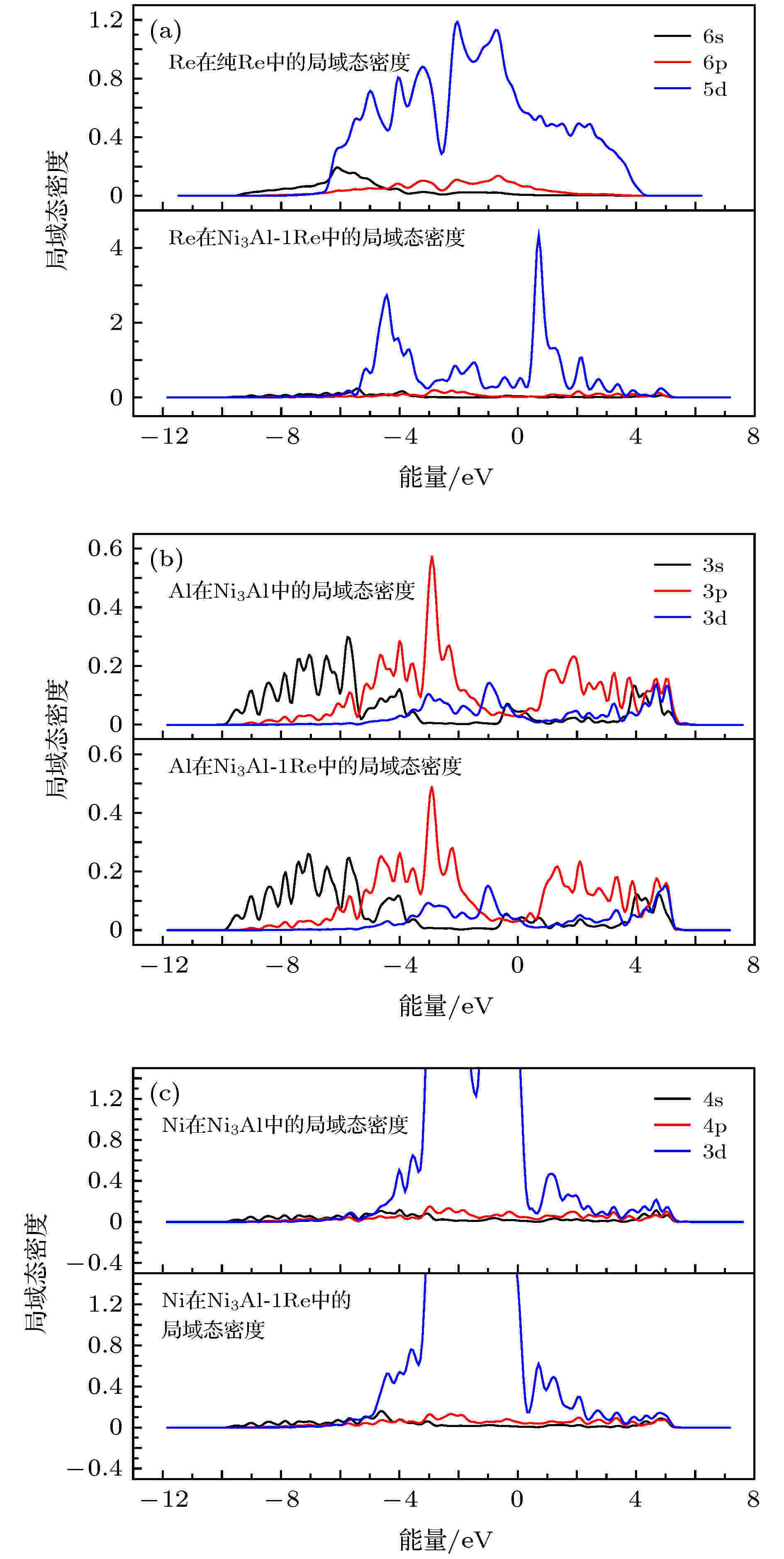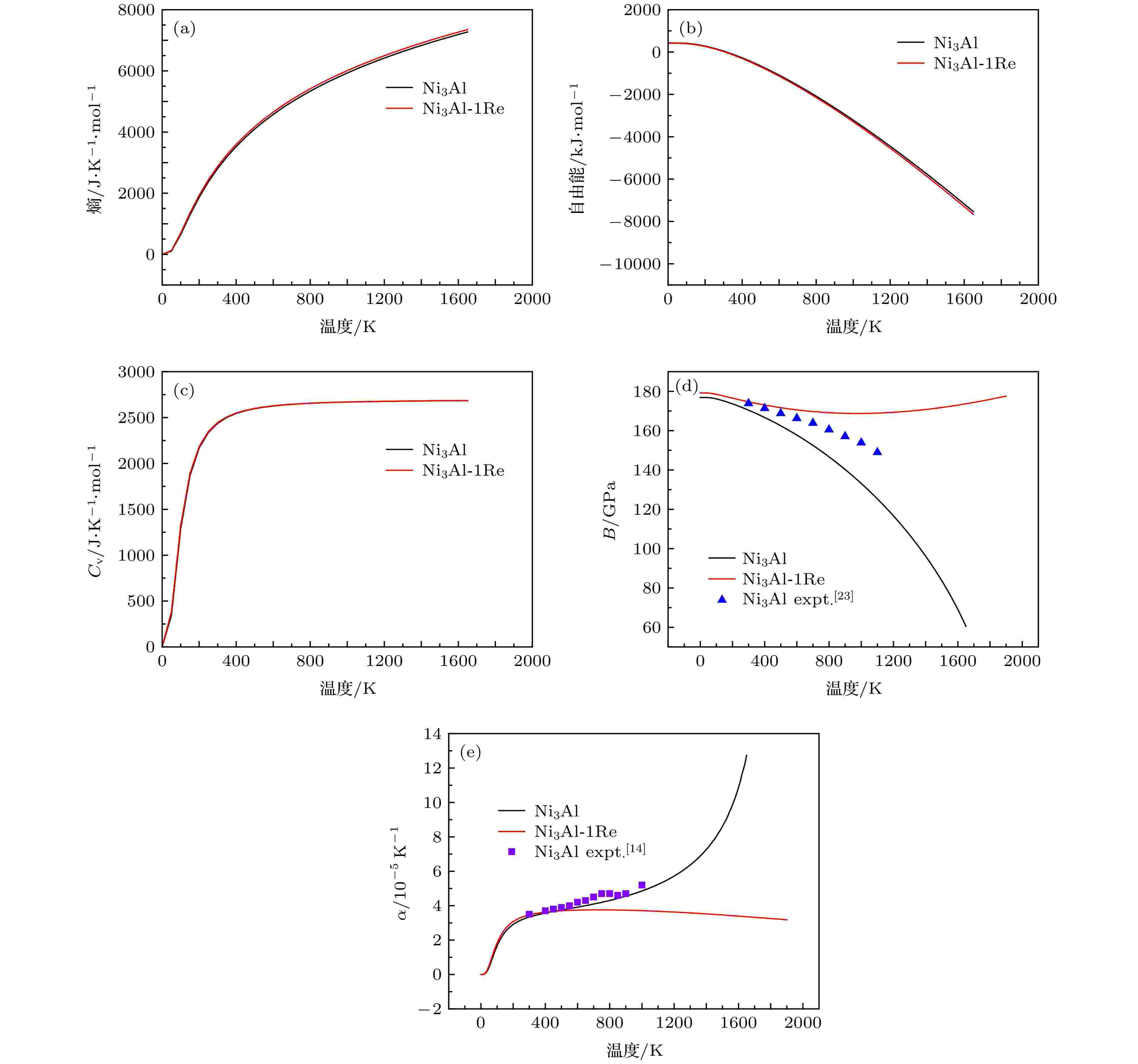全文HTML
--> --> -->尽管Ni3Al合金有着许多优良的性能, 但是其韧性较差, 屈服强度较低, 并且为了满足新一代航空涡轮发动机更高的要求, 人们发现在Ni3Al合金中可添加一些合金元素进一步对其力学性能进行改善和提高. 目前的研究表明, Fe对Ni3Al合金的延展性和机械性能具有增强的作用[6]. Cr元素的掺杂能够增加Ni3Al的体积模量[7]. Mo, Ta, W, Ti, Nb和Ru元素的掺杂增加单晶Ni3Al的杨氏模量和剪切模量[8]. Be元素能使Ni3Al塑性提高, 添加1%(原子)Be, 可使延伸率达到5%[9]. Mn元素可以改善Ni3Al合金的室温拉伸性能, 随着Mn含量的增多, 合金屈服强度及延伸率均相应提高[10]. Zr和Hf能够提高Ni3Al合金的流变应力以及

3.1.Re在Ni3Al中的溶解能
为了研究Re对Ni3Al微观结构及力学性质的影响, 需确定Re在Ni3Al中的最优位置. Re和Ni的原子半径均为135 pm, Al的原子半径为125 pm, 考虑到Re的原子半径与Ni, Al原子的半径相近, 以及Ni3Al的L12面心立方结构, 因此在计算时选择Ni位、Al位和在L12结构中空间较大的八面体间隙位为Re可能的掺杂位置, 如图1所示. 图 1 L12 Ni3Al晶胞及Re可能的掺杂位置示意图 (a) Ni3Al晶胞示意图; (b) Al替代位; (c) Ni替代位; (d) 八面体间隙位置
图 1 L12 Ni3Al晶胞及Re可能的掺杂位置示意图 (a) Ni3Al晶胞示意图; (b) Al替代位; (c) Ni替代位; (d) 八面体间隙位置Figure1. The crystal structure of L12 Ni3Al and different sites for Re in Ni3Al: (a) The crystal structure of Ni3Al; (b) Al substitution site; (c) Ni substitution site; (d) octahedral interstitial site.
Re的能量最稳定位置需通过计算Re在Ni3Al中三种不同位置的溶解能来判断, 替位溶解能和间隙溶解能的公式如下[15,16]:














 图 2 Re替代Ni位、替代Al位和占据八面体间隙的情况下溶解能随Ni/Al的浓度变化图
图 2 Re替代Ni位、替代Al位和占据八面体间隙的情况下溶解能随Ni/Al的浓度变化图Figure2. The variation of dissolution energy with Ni/Al concentration when Re is substituted for Ni or Al site or occupied octahedral interstice.
由图2可知, 在整个化学计量比的范围内, Re位于八面体间隙的溶解能大于Re位于替代位的溶解能. 在大部分的化学计量比范围内, Re替代Al位的溶解能小于Re替代Ni位的溶解能, 且

2
3.2.Re对Ni3Al微观结构的影响
33.2.1.Re对Ni3Al晶胞结构的影响
在晶胞结构方面, 研究了Re对Ni3Al晶格常数和化学键的影响. 当掺杂浓度为0.93%, 即1个Re原子掺杂Ni3Al超晶胞(Ni3Al-1Re), 晶格常数为3.581 ?, 与纯Ni3Al晶格常数的模拟值3.579 ?相比变化不大. 当掺杂浓度为1.85%, 即2个Re原子掺杂Ni3Al超晶胞(Ni3Al-2Re), 晶格常数为3.584 ?, 与纯Ni3Al相比仍然变化不大, 说明Re原子的掺杂对于Ni3Al没有引起严重的晶格畸变. 随着Re掺杂浓度的增加, Ni3Al的晶格常数缓慢增大.由图3(a)和图3(b)分析可知, Re掺杂Ni3Al后, 主要与近邻的Ni原子成键. Re—Ni键键长(2.516, 2.519, 2.516 ?)小于掺杂前Al—Ni键键长(2.527, 2.527, 2.531 ?). Re掺杂前后, 掺杂点位与附近Ni原子所成化学键键角均约为

 图 3 Re替代前后掺杂位置近邻的化学键 (a) Re替代前Al原子与近邻Ni所成的化学键; (b) Re替代后与近邻Ni所成的化学键; (c) Re替代前掺杂点位附近Ni—Ni键和Ni—Al键的情况; (d) Re替代后掺杂点位附近Ni—Ni键和Ni—Al键的情况
图 3 Re替代前后掺杂位置近邻的化学键 (a) Re替代前Al原子与近邻Ni所成的化学键; (b) Re替代后与近邻Ni所成的化学键; (c) Re替代前掺杂点位附近Ni—Ni键和Ni—Al键的情况; (d) Re替代后掺杂点位附近Ni—Ni键和Ni—Al键的情况Figure3. The nearby bonds around doping position before or after Re substitutes: (a) The bonds formed between Al and neighboring Ni before Re substitutes; (b) the bonds formed between Re and neighboring Ni after Re substitutes; (c) the nearby Ni—Ni bonds and Ni—Al bonds around doping position before Re substitutes; (d) the nearby Ni—Ni bonds and Ni—Al bonds around doping position after Re substitutes.
Re掺杂前, 被替代的Al原子附近的Ni-Ni键键长分别为2.531, 2.527, 2.531和2.527 ?, 附近的Ni—Al键键长均为2.531 ?. Re掺杂后, Re原子附近的Ni—Ni键键长分别为2.515, 2.515, 2.534和2.534 ?, 附近的Ni—Al键键长分别为2.547, 2.559和2.547 ?. 说明Re的加入使得附近Ni—Al键键长增大, 键能降低, 使得附近的部分Ni—Ni键键长减小, 键能增强, 部分Ni—Ni键键长增大, 键能降低.
3
3.2.2.Re对Ni3Al电荷密度的影响
为了进一步研究Re对Ni3Al微观结构的影响, 对Re掺杂后附近的差分电荷密度进行分析. 差分电荷密度即:

在图4中, 黄色区域代表电荷数增加, 蓝色区域代表电荷数减少, 差分电荷密度呈对称分布. 从图4可以观察到, 电荷主要汇聚在Re原子与近邻Ni原子的连线区域, 说明Re的掺杂增强了与Ni原子的相互作用, Re与Ni原子之间的成键作用较强. 从近邻Ni原子的角度分析, Ni在向着Re原子的方向上得电荷, 在背着Re原子的方向上(即向着外围Al原子的方向)失电荷, 说明相比于从Al处吸引电荷, Ni原子更易于从Re处吸引电荷. 关于掺杂2个Re原子, 在Ni3Al超晶胞中, 2个Re原子的相对位置情况有三种, 设Ni3Al超晶胞的边长为3a, 三种相对位置分别是2个Re原子的间距为a,


 图 4 Re掺杂后掺杂点位附近的差分电荷密度
图 4 Re掺杂后掺杂点位附近的差分电荷密度Figure4. The differential charge density around the doping position after Re substitutes.
| 相对位 置情况 | 2个Re原子 相距a | 2个Re原子 相距$\sqrt 2 a$ | 2个Re原子 相距$\sqrt 3 a$ |
| 晶胞能量/eV | –604.81 | –604.85 | –604.88 |
表1Ni3Al超晶胞能量与2个Re原子间距的关系
Table1.Relation between the energy of Ni3Al supercell and the distance between 2 Re atoms.
Ni3Al超晶胞中掺杂的2个Re原子间距越大, 晶胞能量越小, 晶胞越稳定. 因此, 2个Re在Ni3Al中的最优掺杂位置为相距

3
3.2.3.Re对Ni3Al态密度的影响
从差分电荷密度图不能完全分析出成键情况, 因此从态密度的角度进一步分析. 纯Ni3Al体系和Ni3Al-1Re (掺杂1个Re原子)体系的总态密度如图5所示. 图 5 纯Ni3Al和Ni3Al-1Re体系的总态密度
图 5 纯Ni3Al和Ni3Al-1Re体系的总态密度Figure5. The total density of states of Ni3Al and Ni3Al-1Re.
关于总态密度, 费米能附近主要的峰是由Ni-Al键引起的. 通过图5发现, 在费米能附近, Ni3Al-1Re体系的峰略低于纯Ni3Al体系的峰, 说明Re的掺杂削弱了Ni-Al键, 使得Ni-Al键的键能降低, 此结论与3.2.1节中所得结论一致. 为了进一步讨论Re原子与体系中的Ni或Al原子发生的轨道相互作用, 分别计算了Re原子、与Re近邻的Ni和Al原子的局域态密度.
通过图6(a)可以分析, 在Re原子掺杂前后, Re的局域态密度的变化. Re加入后, Re原子的5d轨道相比于其他轨道变化明显, 并且5d轨道的局域态密度在约–4.5和0.75 eV处形成峰值, 说明在这两个能量附近存在较多的电子分布, Re加入后与体系中其他原子发生相互作用.
 图 6 Re, 与Re近邻的Al和与Re近邻的Ni的局域态密度 (a) Re原子在纯Re和在Ni3Al-1Re中的局域态密度; (b)与Re近邻的Al在Ni3Al和Ni3Al-1Re中的局域态密度; (c)与Re近邻的Ni在Ni3Al和Ni3Al-1Re中的局域态密度
图 6 Re, 与Re近邻的Al和与Re近邻的Ni的局域态密度 (a) Re原子在纯Re和在Ni3Al-1Re中的局域态密度; (b)与Re近邻的Al在Ni3Al和Ni3Al-1Re中的局域态密度; (c)与Re近邻的Ni在Ni3Al和Ni3Al-1Re中的局域态密度Figure6. Local density of states(LDOS) of Re, Al(next to Re) and Ni(next to Re): (a) LDOS of Re in pure Re and in Ni3Al-1Re; (b) LDOS of Al(next to Re) in Ni3Al and in Ni3Al-1Re; (c) LDOS of Ni(next to Re) in Ni3Al and in Ni3Al-1Re.
关于与Re近邻的Al的局域态密度, 如图6(b)所示, 在Re原子局域态密度出现峰值的区域, 只有Al的3s轨道在–4.5和0.75 eV处产生小峰, 但是变化幅度很小, 说明在Ni3Al-1Re体系中, Re的5d轨道与近邻Al原子的3s轨道存在微小的相互作用.
图6(c)显示与Re近邻的Ni原子局域态密度, 相较于Ni原子的4s轨道和4p轨道, Ni原子3d轨道的态密度值很大. 3d轨道在约–4.5和0.75 eV处出现小峰, 与Re原子的5d轨道在同一位置出现峰值, 而Ni原子的4s轨道和4p轨道整体上变化很小, 且没有在–4.5和0.75 eV两个能量点处形成峰, 因此说明Re掺杂Ni3Al后, Re的5d轨道与邻近Ni原子的3d轨道存在相互作用.
2
3.3.Re对Ni3Al力学性质的影响
在微观结构方面, Re掺杂后主要增强了与近邻Ni原子间的相互作用, 并导致附近Ni—Al键键能降低. 材料内部结构的变化往往会引起其力学性质的改变, 因此从弹性模量、热力学性质两方面探究Re的掺杂对Ni3Al金属间化合物力学性质的影响.3
3.3.1.Re对Ni3Al弹性模量的影响
本小节主要计算了Ni3Al-1Re (掺杂浓度0.93%)、Ni3Al-2Re (掺杂浓度1.85%)和纯Ni3Al体系的弹性常数、体弹性模量、杨氏模量和剪切模量等.为了更好地比较加入Re原子前后的影响, 首先计算纯Ni3Al的弹性常数c11, c12和c44. 对于立方晶系, c11, c12和c44是全部的弹性常数, 计算结果为c11 = 233.2 GPa, c12 = 152.6 GPa, c44 = 118.1 GPa. 体弹性模量B, 剪切模量G, 杨氏模量E可由下面的公式计算:
| c11/GPa | c12/GPa | c44/GPa | B/GPa | G/GPa | E/GPa | c12 – c44 | G/B | |
| Ni3Al | 233.2 | 152.6 | 118.1 | 179.5 | 87.0 | 224.7 | 34.5 | 0.48 |
| Calc1[11] | $227 \pm 5$ | $148 \pm 5$ | $120 \pm 2$ | — | — | — | — | — |
| Calc2[22] | 242.6 | 149.3 | 130.3 | 180.4 | 86.4 | 223.0 | — | — |
| Expt1[11] | 220.1 | 146.0 | 123.6 | 171.0 | 79.0 | 205.0 | — | — |
| Expt2[23] | 225.0 | 149.0 | 124.0 | 174.3 | 77.3 | 202.1 | — | — |
| Ni3Al-1Re | 236.7 | 153.7 | 118.8 | 181.4 | 87.9 | 227.0 | 34.9 | 0.48 |
| Ni3Al-2Re | 241.8 | 154.5 | 120.8 | 183.6 | 89.9 | 231.9 | 33.7 | 0.49 |
表2Ni3Al弹性常数和弹性模量的计算值与其他研究的计算值和实验值的对比以及Ni3Al-1Re, Ni3Al-2Re弹性常数等物理量的计算值
Table2.Comparison of calculated values of elastic constant and modulus of Ni3Al with other calculated, experimental values and calculated values of some physical parameters of Ni3Al-1Re and Ni3Al-2Re.
由表2可以看出, Ni3Al的弹性常数和三种弹性模量与其他相关研究的计算值和实验值相差不大. 与纯Ni3Al相比, 当Re的掺杂浓度为0.93%时, 体弹性模量增加1.1%, 剪切模量增加1.0%, 杨氏模量增加1.0%; 当Re的掺杂浓度为1.85%时, 体弹性模量增加3.7%, 剪切模量增加3.3%, 杨氏模量增加3.2%, 说明Re的掺杂能够增加Ni3Al的刚性和硬度, 但是增加的效果不显著. 随着Re掺杂浓度的升高, 增加效果呈上升趋势. 弹性性能是与合金的室温和高温强度都密切相关的最基本的性能, 因此Re提高了Ni3Al的刚性和硬度, 能够从一些实验研究结果上得以验证[24,25].
G/B值表征材料塑性变形的阻力, 该值越大材料越脆, 该值越小材料韧性越好[26]. 比较G/B值发现, 尽管Ni3Al-1Re, Ni3Al-2Re与纯Ni3Al相比结果没有显著变化, 但是根据Pugh的经验判据,

3
3.3.2.Re对Ni3Al热力学性质的影响
为了探究在不同温度下Re对Ni3Al力学性质的影响, 对第一性原理计算结果进行温度修正, 论文采用声子谱计算对纯Ni3Al晶胞和掺杂1个Re原子的Ni3Al晶胞的熵、自由能和定体热容进行计算. 另外, 采用了准谐波近似方法计算未掺杂晶胞和掺杂晶胞的体弹性模量B和热膨胀系数
由图7(a)可以看出, 在温度区间为[0, 1650 K], Ni3Al-1Re的熵总是略大于未掺杂晶胞. 一般固体的熵来自晶格振动所引起的各种量子态[28], 掺杂Re后, 增加了体系内原子在原晶格上的排列方式, 进而增加了系统中振动的微观态数目. 根据(12)式, 有
 图 7 Ni3Al和Ni3Al-1Re的热力学性质随温度的变化曲线 (a) Ni3Al和Ni3Al-1Re的熵随温度的变化曲线; (b) Ni3Al和Ni3Al-1Re的亥姆霍兹自由能随温度的变化曲线; (c) Ni3Al和Ni3Al-1Re的定体热容随温度的变化曲线; (d) Ni3Al和Ni3Al-1Re的体弹性模量随温度的变化曲线; (e) Ni3Al和Ni3Al-1Re的热膨胀系数随温度的变化曲线
图 7 Ni3Al和Ni3Al-1Re的热力学性质随温度的变化曲线 (a) Ni3Al和Ni3Al-1Re的熵随温度的变化曲线; (b) Ni3Al和Ni3Al-1Re的亥姆霍兹自由能随温度的变化曲线; (c) Ni3Al和Ni3Al-1Re的定体热容随温度的变化曲线; (d) Ni3Al和Ni3Al-1Re的体弹性模量随温度的变化曲线; (e) Ni3Al和Ni3Al-1Re的热膨胀系数随温度的变化曲线Figure7. Thermal properties of Ni3Al and Ni3Al-1Re as a function of temperature: (a) Entropy of Ni3Al and Ni3Al-1Re as a function of temperature; (b) Helmholtz free energy of Ni3Al and Ni3Al-1Re as a function of temperature; (c)


图7(b)为Ni3Al和Ni3Al-1Re的自由能随温度的变化曲线. 由图7(b)可知, 掺杂晶胞的自由能略小于未掺杂晶胞. 此处的自由能为亥姆霍兹自由能, 关于亥姆霍兹自由能可定义如下:



根据图7(c)可知, Re掺杂后, 晶胞的定体热容与未掺杂时相比几乎不变. 在德拜理论中, 通过分析晶格的振动模计算热容量, 每一个振动模的热容量只取决于它的频率, 而整个晶胞的热容量是许多个振动模的热容量在频谱上的积分. 因此, 说明Re掺杂后的Ni3Al在受热过程中所产生的振动频率与纯Ni3Al相比相差不大.
计算Ni3Al-1Re的体弹性模量和热膨胀系数时, 考虑温度区间为[0, 1900 K], 1900 K为目前航空发动机所能达到的最大涡轮前温度. 在图7(d)中, 计算的Ni3Al体弹性模量随温度的变化趋势与实验结果一致[23]. Re的掺杂增加了Ni3Al的体弹性模量. 在低温时, Ni3Al-1Re的体弹性模量略大于Ni3Al, 而在高温时, Ni3Al-1Re的体弹性模量远远大于Ni3Al. Ni3Al的体弹性模量随温度的升高而降低, 这是因为温度的升高使得晶胞中的原子产生更大的动能, 导致原子更易于偏离其平衡位置, 而弹性模量表示使原子离开平衡位置的难易程度[29], 因此温度的升高使得Ni3Al的体弹性模量降低. 掺杂Re后, 体弹性模量没有随温度的升高而明显降低, 说明Re不易使Ni3Al晶胞内的原子偏离其平衡位置, Re增强了Ni3Al中原子间结合力.
图7(e)为Ni3Al和Ni3Al-1Re热膨胀系数随温度的变化曲线, 其中Ni3Al的计算结果与实验结果符合得较好[14]. Ni3Al晶胞的


















